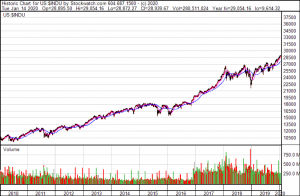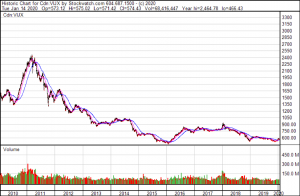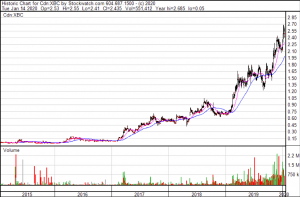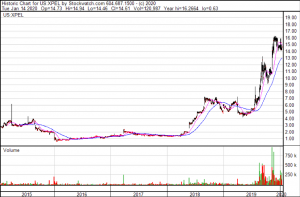Stocks & Equities
David Rosenberg explores Recession Arithmetic in today’s Breakfast With Dave. I add a few charts of my own to discuss.
Rosenberg notes “Private fixed investment has declined two quarters in a row as of 2019 Q3. Since 1980, this has only happened twice outside of a recession.”
Since 1980 there have been five recessions in the U.S.and only once, after the dotcom bust in 2001, was there a recession that didn’t feature an outright decline in consumption expenditures in at least one quarter. Importantly, even historical comparisons are complicated. The economy has changed over the last 40 years. As an example, in Q4 of 1979, fixed investment was 20% of GDP, while in 2019 it makes up 17%. Meanwhile, imports have expanded from 10% of GDP to 15% and the consumer’s role has risen from 61% to 68% of the economy. All that to say, as the structure of the economy has evolved so too has its susceptibility to risks. The implication is that historical shocks would have different effects today than they did 40 years ago….CLICK for complete article
In the 1940s, Henry Ford regaled us with this little fantastical gem: “Mark my words – a combination aeroplane and motor car is coming…You may smile. But it will come.” Eight decades later, and Ford is vindicated. Toyota just made a nearly $400-million bet on flying taxis as tech competition in this segment gets fierce.
The Japanese carmaker said it is investing $394 million in California-based Joby Aviation, an aerospace company that hopes to be among the first to develop and commercialize all-electric flying taxis.
It’s the second time Toyota has seen fit to pump money into this idea.
In early 2018, the Japanese auto giant teamed up with Jetblue, investing $100 million in Joby during the company’s previous funding round. With Toyota’s latest investment, Joby just closed its latest round of financing with $590 million in venture capital funding.
And the year before that, Toyota backed Recogni Inc., a Silicon Valley maker of autonomous vehicle systems, and May Mobility, a Michigan-based operator of self-driving shuttle buses….CLICK for complete article
No One’s Saying It But We Will. Will Canadian Micro-Cap Stocks Rebound?
If you’re a professional money manager or an investor, markets have provided staggering opportunities to create wealth with almost all markets melting higher.
Last year in 2019, the S&P 500 was up more than 30%, and just about every investor in large caps made money. With the influx of ETFs, it’s been relatively cheap and easy for investors to participate in the market. Investment demand for ETF products has helped push the valuations of the largest companies by market capitalization to a point where low-growth, mature companies are trading at high multiples. Look at McDonald’s (MCD – NYSE) which currently trades at a price to earnings ratio of 27.
Meanwhile, Silicon Valley has also been thriving, and the abundance of funds in venture capital and private equity has propelled private company valuations to the point where venture capital firms are selling companies to each other at ever-increasing valuations, much like the game of hot potato. Some of the “unicorns” have been floated to the public via IPO’s at stratospheric valuations.
And of course, with no shortage of headlines, there is real estate: property prices have been steadily climbing to unprecedented highs over the last decade, fueled by cheap debt and falling interest rates.
Almost every asset class has seen a protracted move to near historically high valuation multiples.

What does this mean for average retail investors? Are there any asset classes available to the retail investor that has lagged? We believe so.
In our opinion, and there is enough evidence to argue this, the micro-cap sector is one of the last frontiers left for investors and money managers to uncover deep value. Here’s how the TSX Venture exchange has fared over the last 10 years:

Over the last several years, aside from marijuana and blockchain, the Canadian micro-cap market has been relatively ignored and left for dead. One of our favorite statements, which is an adaptation to the famous Rothschild quote is, “The time to buy is when there’s nobody in the streets”, and until very recently, this is exactly what we’ve seen.
The trading volume on quality micro-cap companies has dried up over the past several years as more obvious market trends and bubbles have robbed liquidity. This dynamic has been driving institutional capital away from quality micro-cap companies, forcing the ecosystem of investors, fund managers and institutions to move higher up the market cap food chain, making the micro-cap market even more illiquid.
For years this segment of the market has been unloved and has had virtually zero competition. It’s been a buyer’s market. But only for very patient buyers.
Companies would announce new contracts, positive financials or a successful acquisition, yet every uptick in price was met with sellers using it as an opportunity to exit the company. And if the Company was not part of one of the trendy sectors, good luck trying to raise capital.
It was a painful cycle in the micro-cap market for quality companies as ultimately shares prices trended lower as investors had no interest or appetite for these types of companies. It was a vicious feedback loop. Lower liquidity kept more investors away causing lower liquidity, rinse, repeat. While it’s been a difficult waiting game as the share prices of most of the companies we own or follow drifted lower, it’s also created one of the biggest opportunities we’ve seen in the past decade.
Investors and market enthusiasts who follow the companies that meet our criteria have all been asking the same question – what’s going to change the sentiment? What’s it going to take to have a bull market again?
Unbeknownst to most of the market, the Canadian micro-cap market is rapidly changing and it’s happening in stealth. To the untrained eye, it seems as if there’s no pattern or emerging trend, but there is. It’s a flight to quality as the companies, which are now starting to gain interest, are what we consider quality microcaps as dictated by there revenue growth, earnings, and EBITDA. Many of these companies are starting to rapidly re-price higher and some are trading at multi-year high prices. The feedback loop is starting to work in the opposite direction.
We believe it started with companies such as Xpel Technologies (now listed on Nasdaq, XPEL-Q), Xebec Adsorption Inc (XBC-TSX.V), Sangoma Technologies Corporation (STC-TSX.V), and Well Health Technologies Corp (WELL-TSX.V). All four of these companies have seen there share prices rise by at least 800% over the past four years, with Xebec and Xpel leading the charge returning over 1,700% and 1200% in the past three years. Most of the gains have accelerated in the last 12 months.
Below are the 5-year charts for both Xebec and Xpel:


As these companies have risen to market darling status it’s fattened the wallets for their investors, especially those who were in early. The important take-away is that all three of these companies have similar criteria and those early investors who profited from the rising share prices are looking to place new bets with their newfound profits. Most of these early investors were smaller retail players, not the institutional money.
This process is what fuels the micro-cap market. There needs to be some microcap winners to stimulate investor interest which drives new money into the ecosystem and pulls the institutional money down market. A combination of capital rotation, as investors who have profited off the sale of stock, and new investor interest is the engine for this microcap bull market.
Adding fuel to the fire, in late 2019, there’s been multiple acquisitions in the small stocks including, Intrinsyc Technologies Corporation (ITC-TSX.V), Posera Ltd (PAY-TSX.V), and Iplayco Corporation Ltd (IPC-TSX.V) where the capital from the sale of these companies gets re-circulated throughout the micro-cap marketplace.
Money is flowing into the market and there are numerous indications that a bull market for these types of companies is in full swing.
Almost daily we are seeing new high share prices for a diversified set of companies, spanning technology to renewables, but all of them have the same theme in common; they are higher quality companies.
Here’s an example of just a few of the companies we are seeing generate very strong moves and/or hit new 52-week highs:
Xpel Technologies (XPEL-NASDAQ)
Xebec Adsorption (XBC-TSX.V)
Sangoma Technologies (STC-TSX.V)
Well Health Technologies (WELL-TSX.V)
Namesilo Technologies (URL-CSE)
Atlas Engineering Products (AEP-TSX)
Lite Access Technologies (LTE-TSX.V)
Nova Leap Health (NLH-TSX.V)
MediaValet (MVP-TSX.V)
Innovotech Inc (IOT-TSX.V)
Network Media Group (NTE-TSX.V)
Greenlane Renewables (GRN-TSX.V)
Cematrix (CVX-TSX.V)
CRH Medical Corporation (CRH-TSX)
AirIQ Inc (IQ-TSX.V)
Last week, we witnessed one of our long-time favorites, an illiquid micro-cap called Namsys Inc (CTZ-TSX.V), file an alternative report which announced a Los-Angeles based fund, Topline Capital has accumulated over 12% of the Company. It too broke out of a 3-year trading range and hit an all-time high in the share price. It’s another signal that money is moving down the market as this tiny $27M market cap company is attracting larger pools of capital. This is a trend we expect to continue.
However, very few prognosticators and TV talking heads are calling it a bull market in the Canadian microcaps and some are still unsettled by their losses from the recent breakdown in share prices for the marijuana sector. This adds to our thinking for why we believe it’s a bull market, and we think we are only in the 1st or 2nd inning of this new microcap bull market.
To have a true bull market though, there needs to be a wall of worry to overcome. There must be people betting against it and a group of doubters that will eventually switch sides. You’ll hear big market multiples are too high, the bull market has run too long, interest rates, economy, etc., etc.
We believe this is a once in a decade micro-cap bull market that needs to catch up to the other markets and assets. It’s already started, the engine is firing, and the gears are greased as this rocket is taking off. We think we have at least 1 ½ to 2 years to go. The best way to take advantage of the type of environment we are currently in is the most challenging part of this business. All the hard work and time spent buying and researching companies will be rewarded to the investors who are most patient. It’s a double down on what you own and hold what you own type of market as any incremental buying is pushing shares to new highs. Don’t get fooled by the first jump in the share price of your microcap. It’s likely just the start of a big run in price to catch up to all the over-priced assets everywhere else.
To your wealth,
Paul, Brandon and Trevor
www.smallcapdiscoveries.com
Bullish calls included a software leader and a discount airline.
Bearish calls included an electric vehicle giant and a cult food stock.
Benzinga continues to examine the prospects for many of the stocks most popular with investors. The following are just a few of this past week’s most bullish and bearish posts that are worth another look.
Several large options traders were mostly bullish on Microsoft Corporation this past week, according to Wayne Duggan’s “Microsoft Sees Bullish Option Activity As Stock Hits New All-Time High.” How much more upside is there? CLICK for complete article
Constellation Brands, Inc. reported fiscal third-quarter results Wednesday, and CEO Bill Newlands was a guest on CNBC’s “Mad Money” to offer his take.
‘Scratching The Surface’ With Modelo
Constellation’s Modelo Especial is not only one of the few beer brands showing growth, but it is the “No. 4 beer brand” in the entire beer category with tremendous upside, Newlands told Jim Cramer.
The company has seen notable growth over the years, going from 35 million cases in 2009 to 140 million cases last year….CLICK for complete article













